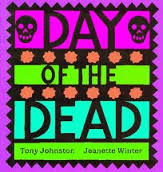

One Mexican Family Begins Preparations for an Annual Celebration: The Day of the Dead
Day of the Dead
By Tony Johnston; illustrated by Jeanette Winter
In Mexico, Central and South America, The Day of the Dead is celebrated for a three day period, depending on the locality, from October 31st through November 2nd.
It actually coincides with two other religiously observed holy days; All Saints Day on November 1st and All Souls Day on November 2nd which encourages Catholics to also honor in prayer and visitation to gravesides, family and friends that have died.
In Day of the Dead, Tony Johnston takes the young reader on one family’s preparation, in a small town in Mexico, for “El día de los muertos,” as seen through the eyes of young ones who are told to “Wait,” or “Espérense,” each time they long to see and sample the daily preparations for the feast.
Roosters crow, the sun rises and children awake to their Mama preparing “empanadas” that are “little pastries with meat.” Their every cry for a taste is always met with the repetition throughout the picture book of the word, “Espérense,” to “Wait” that merely whets the anticipation and appetite all the more.
“Tios” or uncles, pick golden oranges and apples for the celebration, chiles are ground to powder, packages from the bakery are brought into the house, mama bakes the flower-decorated “pan de muertos” or bread of the dead, freshly made tamales are made by the entire family and again the children try to sneak a taste, followed by the repeated, “Espérense.” Wait!
Cut sugar canes are brought in from the fields whose sweetness longs to be sipped through, like a straw, and “las tias”, a sauce made of the ground chiles and chocolate, plus the final addition of chicken, transforms all three into a “mole.” You can fairly smell the scents of the holiday in this picture book.
Bunches of golden-orbed marigolds, or “zempasúchil” are brought from the market and made into bouquets.
Finally, the procession starts with petals, strewn by the families along the road as they go. This, in order for the spirits to find their way, along with the families, to the graveyard, and all are accompanied by a host of brightly lit candles that people carry.
The glowing candles are placed surrounding the graves and the singing, dancing and feasting commences.
At the graves of the “los abuelos” or grandparents, they are respectfully remembered with love. Salt and water that are symbols of “ongoing life” are placed on the graves.
“The Calaveras de azúcar” or heavily decorated “sugar skulls” are unwrapped to squeals of delight by the children and enjoyed.
After the feasting there are the golden marigolds that are left atop the graves as the tired and sleeping children are carried home in the arms of their parents.
Tony Johnston’s small-sized picture book is a perfect read-aloud one on one to give your child a view of a different culture’s preparation and celebration honoring those that have passed, but are still quite alive in the memories and hearts of their families.
And, Jeanette Winter does an excellent job presenting the narrative with small pictures framed by all the symbols of the feast, showing all the family and food-centered preparations that precede “El día de los muertos.”
Food and family are interlinked in many culture’s celebrations. So, it seems that the interlinking of both does not end in Mexico with the death of loved ones.
It is a beautiful tradition of remembrance.
.
While it may seem unfamiliar to some, El día de los muertos is quite a moving memory celebration. For as a friend once told me, “So long as a deceased person’s name is said out loud, so long will they be held in memory in the hearts of those that loved them and they loved.” They will continue to live.
And that is quite something for young readers to hold onto as a belief.
